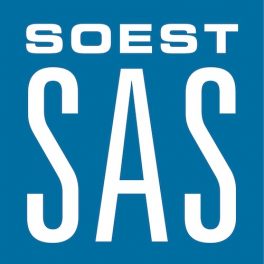Paul Wessel, emeritus professor with the SOEST Department of Earth Sciences; Seung-Sep Kim, SOEST alum and professor at Chungnam National University (Korea); and researchers from Scripps Institution of Oceanography recently published a study identifying 19,325 new seamounts. This work expanded a previously published catalog that had 24,643 seamounts.
The journal Science shared this discovery as a News feature. Excerpts of that article are below.
With only one-quarter of the sea floor mapped with sonar, it is impossible to know how many seamounts exist. But radar satellites that measure ocean height can also find them, by looking for subtle signs of seawater mounding above a hidden seamount, tugged by its gravity. A 2011 census using the method found more than 24,000. High-resolution radar data have now added more than 19,000 new ones. The vast majority—more than 27,000—remain uncharted by sonar. “It’s just mind boggling,” says David Sandwell, a marine geophysicist at the Scripps Institution of Oceanography, who helped lead the work.
Published this month in Earth and Space Science, the new seamount catalog is “a great step forward,” says Larry Mayer, director of the University of New Hampshire’s Center for Coastal and Ocean Mapping. Besides posing navigational hazards, the mountains harbor rare-earth minerals that make them commercial targets for deep-sea miners. Their size and distribution hold clues to plate tectonics and magmatism. They are crucial oases for marine life. And they are pot-stirrers that help control the large-scale ocean flows responsible for sequestering vast amounts of heat and carbon dioxide, says John Lowell, chief hydrographer of the National Geospatial-Intelligence Agency (NGA), which runs the U.S. military’s satellite mapping efforts. “The better we understand the shape of the sea floor, the better we can prepare [for climate change].”
Sandwell and his colleagues secured funding from the Navy and NGA to hunt for seamounts with satellites. They identified thousands, including 700 particularly shallow ones that posed hazards to submarines. But the team knew its first catalog was far from complete. Now, armed with data from high-resolution radar satellites, including the European Space Agency’s CryoSat-2 and SARAL from the Indian and French space agencies, the team can detect seamounts just 1100 meters tall—close to the lower limit of what defines a seamount, Sandwell says.
Seamounts often occur in chains formed as tectonic plates ride over stationary plumes of hot rock rising from the mantle. As a result, the catalog will pay immediate dividends for studies of Earth’s interior, says Carmen Gaina, a geophysicist at the Queensland University of Technology. It has already identified new seamounts in the northeast Atlantic Ocean that could help track the evolution of the mantle plume that feeds Iceland’s volcanoes. The survey also spotted seamounts near a ridge in the Indian Ocean where fresh crust is made as tectonic plates spread apart. They suggest a surprising amount of volcanism in a region once thought to be magma starved, Gaina says.
To biologists, seamounts’ steep slopes resemble crowded, boisterous skyscrapers for corals and other marine life. “They’re oases for biodiversity and biomass,” says Amy Baco-Taylor, a deep-sea biologist at Florida State University. Whales use them as waypoints. But biologists debate the role seamounts play in marine biodiversity: Are they home to genetically distinct species, like remote islands? Or do they serve as stepping stones for life to hopscotch through the oceans? By pushing up the density of seamounts, the new maps could strengthen the argument for the latter, Baco-Taylor says.
They will also boost efforts to protect biodiversity in international waters under a new marine protection treaty. “We can’t protect the things if we don’t know they’re there,” says Chris Yesson, a marine biologist at the Zoological Society of London’s Institute of Zoology. The maps will provide a practical payoff, Yesson adds: “We won’t waste our time as much.” Some of his colleagues, he says, once traveled to the Indian Ocean to study a seamount that turned out to be a phantom created by an error in presonar depth records.
Nowhere will the new maps be as important as in understanding the ocean’s globe-girdling conveyor belt of currents. The currents ferry heat from the equator to the poles, where the water cools and gains density until it plunges downward, carrying heat and carbon dioxide into the abyss. But the flip side of this perpetual motion machine—deep ocean waters defying gravity and rising upward—has long been a mystery. The “upwelling” was once thought to happen evenly across the ocean, driven by turbulent waves at boundaries between deep ocean layers of different densities. Now, researchers believe it is concentrated at seamounts and ridges. “There’s a zoo of interesting things that happen when you have topography,” says Brian Arbic, a physical oceanographer at the University of Michigan, Ann Arbor.
When ocean currents curl around seamounts, they create turbulent “wake vortices” that can provide the energy to push cold water up, says Jonathan Gula, a physical oceanographer at the University of Western Brittany. In unpublished research, Gula and co-authors have found that these wake vortices make seamounts the leading contributor to upward ocean mixing, and a central player in climate. Since the team relied on the old Scripps catalog, not the new one, the effect of the seamounts is probably even larger, Gula adds.
The seamount catalog is sure to expand further with Seabed 2030, an international project to accelerate high-resolution sonar mapping that Mayer is helping lead. But space surveys will improve too. NASA’s Surface Water and Ocean Topography satellite, launched in December 2022, can measure the height of a water surface to within a couple of centimeters. Better remote sensing would be welcome, given the cost of sonar mapping voyages, Mayer says. “I would love to see it threaten what I do.”
Source: Science


























